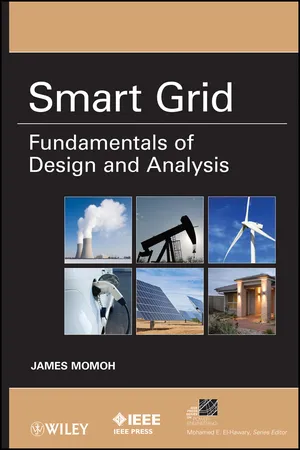
- English
- ePUB (mobile friendly)
- Available on iOS & Android
About this book
The book is written as primer hand book for addressing the fundamentals of smart grid. It provides the working definition the functions, the design criteria and the tools and techniques and technology needed for buildingsmart grid. The book is needed to provide a working guideline in the design, analysis and development of Smart Grid. It incorporates all the essential factors of Smart Grid appropriate for enabling the performance and capability of the power system. There are no comparable books which provide information on the "how to" of the design and analysis.
The book provides a fundamental discussion on the motivation for the smart grid development, the working definition and the tools for analysis and development of the Smart Grid. Standards and requirements needed for designing new devices, systems and products are discussed; the automation and computational techniques need to ensure that the Smart Grid guarantees adaptability, foresight alongside capability of handling new systems and components are discussed. The interoperability of different renewable energy sources are included to ensure that there will be minimum changes in the existing legacy system.
Overall the book evaluates different options of computational intelligence, communication technology and decision support system to design various aspects of Smart Grid. Strategies for demonstration of Smart Grid schemes on selected problems are presented.
Frequently asked questions
- Essential is ideal for learners and professionals who enjoy exploring a wide range of subjects. Access the Essential Library with 800,000+ trusted titles and best-sellers across business, personal growth, and the humanities. Includes unlimited reading time and Standard Read Aloud voice.
- Complete: Perfect for advanced learners and researchers needing full, unrestricted access. Unlock 1.4M+ books across hundreds of subjects, including academic and specialized titles. The Complete Plan also includes advanced features like Premium Read Aloud and Research Assistant.
Please note we cannot support devices running on iOS 13 and Android 7 or earlier. Learn more about using the app.
Information
- Handling uncertainties in schedules and power transfers across regions
- Accommodating renewables
- Optimizing the transfer capability of the transmission and distribution networks and meeting the demand for increased quality and reliable supply
- Managing and resolving unpredictable events and uncertainties in operations and planning more aggressively.
| Preferred Characteristics | Today’s Grid | Smart Grid |
| Active Consumer Participation | Consumers are uninformed and do not participate | Informed, involved consumers—demand response and distributed energy resources |
| Accommodation of all generation and storage options | Dominated by central generation—many obstacles exist for distributed energy resources interconnection | Many distributed energy resources with plug-and-play convenience focus on renewables |
| New products, services, and markets | Limited, poorly integrated wholesale markets; limited opportunities for consumers | Mature, well-integrated wholesale markets; growth of new electricity markets for consumers |
| Provision of power quality for the digital economy | Focus on outages—slow response to power quality issues | Power quality a priority with a variety of quality/price options—rapid resolution of issues |
| Optimization of assets and operates efficiently | Little integration of operational data with asset management—business process silos | Greatly expanded data acquisition of grid parameters; focus on prevention, minimizing impact to consumers |
| Anticipating responses to system disturbances (self-healing) | Responds to prevent further damage; focus on protecting assets following a fault | Automatically detects and responds to problems; focus on prevention, minimizing impact to consumers |
| Resiliency against cyber attack and natural disasters | Vulnerable to malicious acts of terror and natural disasters; slow response | Resilient to cyber attack and natural disasters; rapid restoration capabilities |



Table of contents
- Cover
- IEEE Press
- Title page
- Copyright page
- PREFACE
- 1 SMART GRID ARCHITECTURAL DESIGNS
- 2 SMART GRID COMMUNICATIONS AND MEASUREMENT TECHNOLOGY
- 3 PERFORMANCE ANALYSIS TOOLS FOR SMART GRID DESIGN
- 4 STABILITY ANALYSIS TOOLS FOR SMART GRID
- 5 COMPUTATIONAL TOOLS FOR SMART GRID DESIGN
- 6 PATHWAY FOR DESIGNING SMART GRID
- 7 RENEWABLE ENERGY AND STORAGE
- 8 INTEROPERABILITY, STANDARDS, AND CYBER SECURITY
- 9 RESEARCH, EDUCATION, AND TRAINING FOR THE SMART GRID
- 10 CASE STUDIES AND TESTBEDS FOR THE SMART GRID
- 11 EPILOGUE
- Index
- IEEE Press Series on Power Engineering